
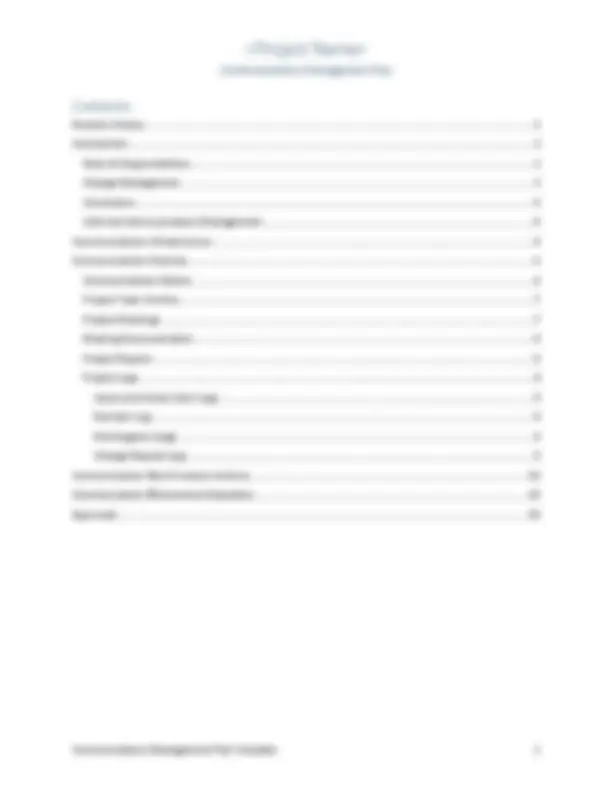

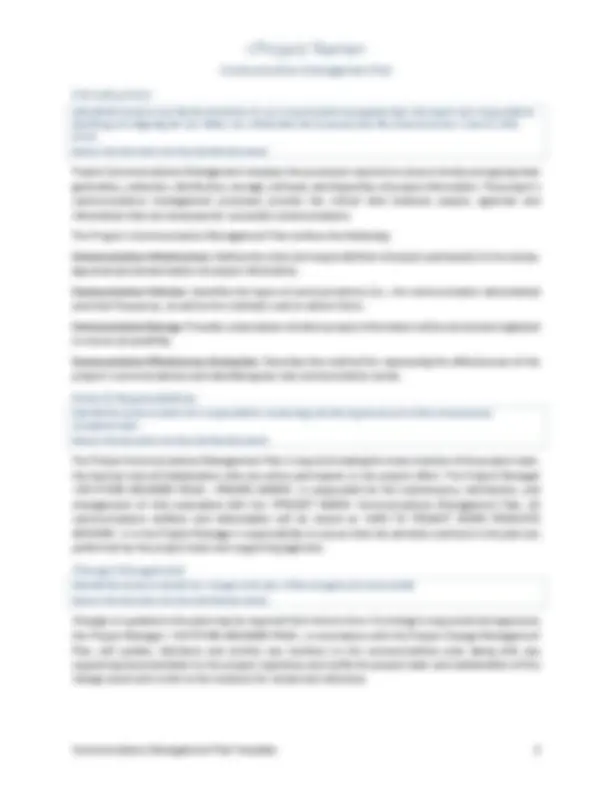
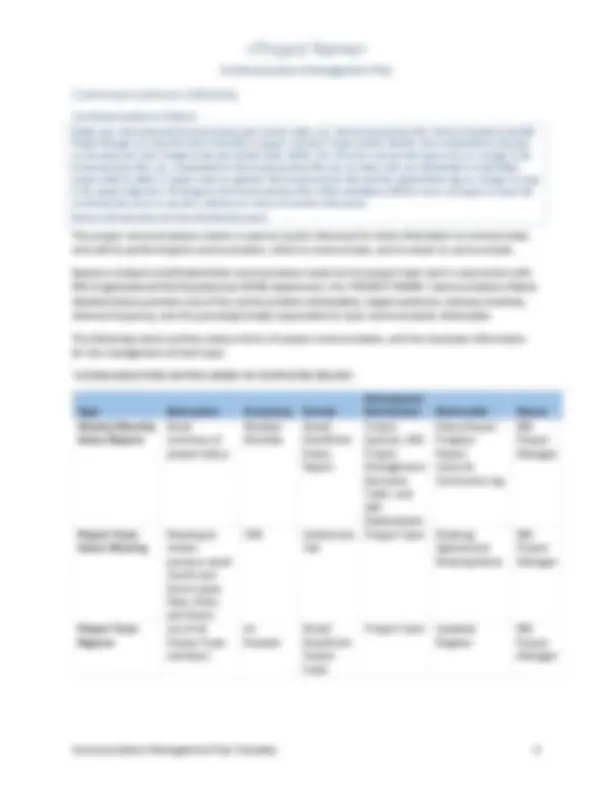
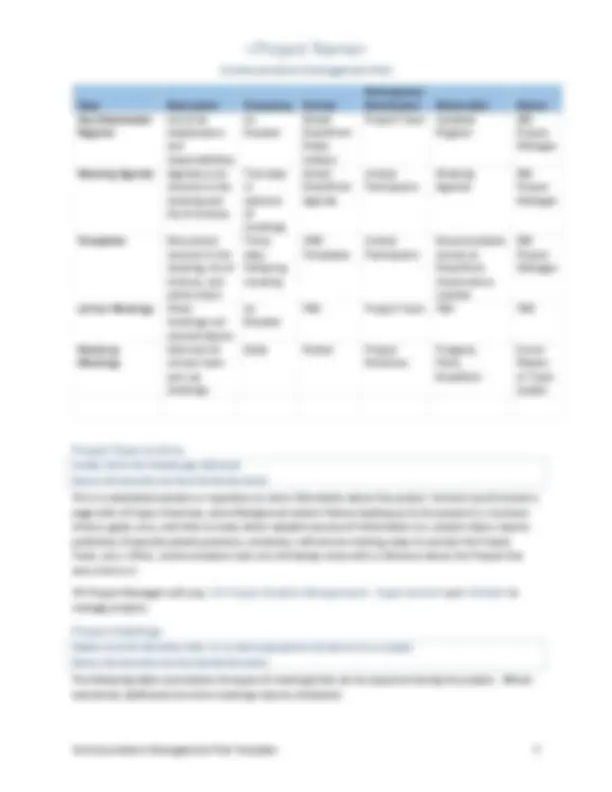
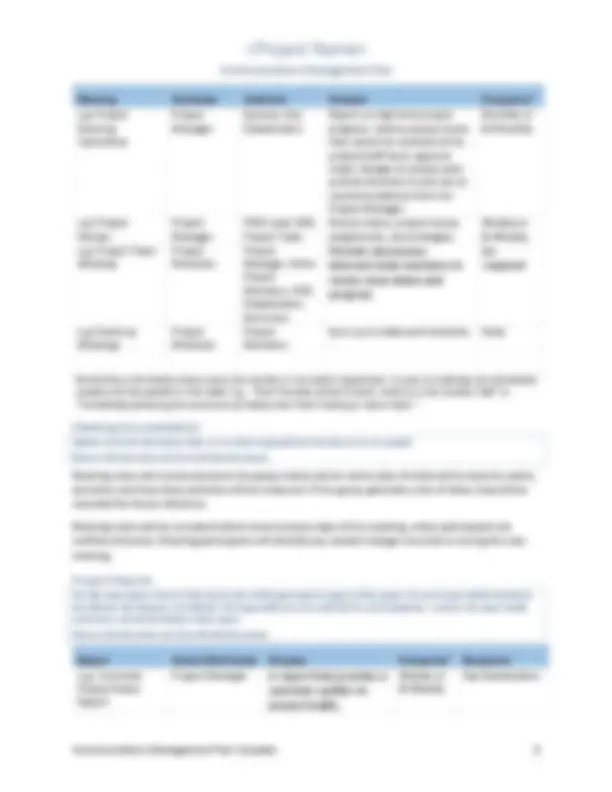


Study with the several resources on Docsity

Earn points by helping other students or get them with a premium plan


Prepare for your exams
Study with the several resources on Docsity

Earn points to download
Earn points by helping other students or get them with a premium plan
Community
Ask the community for help and clear up your study doubts
Discover the best universities in your country according to Docsity users
Free resources
Download our free guides on studying techniques, anxiety management strategies, and thesis advice from Docsity tutors
An outline for creating a Project Communications Plan. It includes the purpose, key elements, and communication infrastructure and storage. The plan serves to provide communication requirements, describe how information will be distributed, and manage collaboration and approved project processes. The document also includes a communications matrix and a list of project stakeholders and their communication requirements.
What you will learn
Typology: Lecture notes
1 / 12

This page cannot be seen from the preview
Don't miss anything!







Version X.XX
Instructions to the Author:
This is a template for developing a project communication plan.
The template includes instructions to the author, boilerplate text, and fields that should be replaced with the values and information specific to the project.
Blue italicized text enclosed in boxes provides instructions to the document author, or describes the intent, assumptions and context of the annotated section. This instructional text should be removed from the final document to make the plan more readable. Italicized text enclosed in angle brackets (
Text and tables with content prefaced with e.g. are provided as examples of wording and/or formats that may be used or modified as required to support a specific project. The information and outline is a suggestion to assist in developing project documents; they are not mandatory formats. The author should tailor the content of the document to fit the project that this work product will support.
Remove these instructions and this page from the final document.
Purpose of the Project Communications Plan: The Project Communications Plan serves to provide the communication requirements for the project and describes how information will be distributed. The plan provides definition to the following components:
Remove this page from the final document.
Revision History
Date Version Author(s) Notes 1/1/2018 0. 01
Introduction
Add/edit this section to provide the introduction to your communications management plan. Document who is responsible for identifying and mitigating the risks. Define who will distribute the Communications Plan material and how/where it will be stored. Remove this instruction text from the final document.
Project Communications Management employs the processes required to ensure timely and appropriate generation, collection, distribution, storage, retrieval, and disposition of project information. The project’s communications management processes provide the critical links between people, agencies and information that are necessary for successful communications.
The Project’s Communication Management Plan outlines the following:
Communication Infrastructure: Defines the roles and responsibilities of project participants in the review, approval and dissemination of project information.
Communication Vehicles: Identifies the types of communications (i.e., the communication deliverables) and their frequency, as well as the methods used to deliver them.
Communication Storage: Provides a description of where project information will be stored and organized to ensure accessibility.
Communication Effectiveness Evaluation: Describes the method for reassessing the effectiveness of the project’s communications and identifying any new communication needs.
Roles & Responsibilities Add/edit this section to detail who is responsible for maintaining and enforcing the tenants of this communications management plan. Remove this instruction text from the final document.
The Project Communications Management Plan is required reading for every member of the project team, the Sponsor and all Stakeholders who are active participants in the project effort. The Project Manager
Change Management Add/edit this section to identify how changes to the plan will be managed and communicated. Remove this instruction text from the final document.
Changes or updates to this plan may be required from time to time. If a change is requested and approved, the Project Manager < OR OTHER ASSIGNED ROLE>, in accordance with the Project Change Management Plan, will update, distribute and archive any revisions to the communications plan along with any supporting documentation to the project repository and notify the project team and stakeholders of this change event with a link to the revisions for review and reference.
Person/Group Type/Level of Communications Enterprise Architecture Committee
The Enterprise Architecture Committee is comprised of the project sponsor, project manager, project solutions architect, and key technical stakeholders. This committee serves as the technical escalation point for enterprise architecture or systems integration related decisions that span multiple agencies
Project Sponsor The Project Sponsor is a state employee who provides high-level direction to and funding oversight for the project, approves all significant decision requests, and acts as the final level of issue resolution within the project.
Project Manager The Project Manager is responsible for managing the project to a successful completion. He/she oversees the planning and scheduling of work, reports progress, identifies and manages project risks, manages resources, ensures a quality configuration, and directs project communications.
Project Team Members/Subject Matter Experts
The project team consists of business representatives, technical support personnel, implementation consultants, training, and quality assurance\testing personnel. They must communicate effectively between themselves, as well as with vendors and stakeholders. They must collaborate to ensure proper system functionality, prepare detailed input for status reports to the Project Manager and generate required site documentation.
Stakeholders Stakeholders include anyone that has an interest in the project. They should be provided information on the status of the project to include achievements, milestones met, and any issues that affect the tasks for which they are responsible.
Change Agents Personnel assigned by the Agencies/Departments impacted by the project and potential changes brought about by the project. Change Agents are an extension of the core Project Team, ensuring details about the project reach the individual users affected, while ensuring user feedback is communicated back to the Project Team. Change Agent Communication and Training may be managed by representatives from Organizational Skill Development (OSD)
Communications Vehicles
Communications Matrix Define who will evaluate the Communications plan and how often, e.g., the Communications Plan will be evaluated by the DSS Project Manager on a quarterly basis to identify any gaps or necessary improvements. Identify when amendments to the plan can be made and when changes to the plan shall be made. Define who will review and provide approval to any changes in the Communications Plan, e.g., amendments to the Communications Plan may be made when new stakeholders are identified, project staff are added, or project roles are updated. The Communications Plan shall be updated following any changes in scope or key project objectives. All changes to the Communications Plan will be submitted to DSS for review and approval. Insert the communication matrix or provide a reference to where it is stored in this section. Remove this instruction text from the final document.
The project communications matrix is used as a quick reference for what information to communicate, who will be performing the communication, when to communicate, and to whom to communicate.
Based on analysis of all Stakeholder communication needs by the project team and in conjunction with DSS Organizational Skill Development (OSD) department, the
The following matrix outlines various forms of project communication, and the necessary information for the management of each type:
Type Description Frequency Format
Participants/ Distribution Deliverable Owner Weekly/Monthly Status Reports
Email summary of project status
Weekly/ Monthly
Email/ SharePoint Status Report
Project Sponsor, DSS Project Management Executive Team, and DSS Stakeholders
Status Report Progress Report Issues & Comments Log
Project Manager
Project Team Status Meeting
Meeting to review previous week results and future week Plans, Risks, and Issues
TBD Conference Call
Project Team Meeting Agenda and Meeting Notes
Project Manager
Project Team Register
List of all Project Team members
As Needed
Email/ SharePoint Project Team
Project Team Updated Register
Project Manager
Meeting Facilitator Audience Purpose Frequency^1 e.g. Project Steering Committee
Project Manager
Sponsor, Key Stakeholders
Report on high level project progress, resolve project issues that cannot be resolved at the project/staff level, approve major changes to project plan, provide direction to and act on recommendations from the Project Manager.
Monthly or Bi-Monthly
e.g. Project Review
Project Manager
PMO Lead, OSD, Project Team
Discuss status, project issues, assignments, and strategies.
Weekly or Bi-Weekly e.g. Project Team Meeting
Project Members
Project Manager, Other Project Members, OSD, Stakeholders, End Users
e.g. Stand-up Meetings
Project Members
Project Members
Sync-up on daily work activities Daily
(^1) Bi-Monthly or Bi-Weekly means every two months or two weeks respectively. As soon as meetings are calendared, update with the specifics in this table. E.g., “third Thursday of each month, 10:00 to 11:00, location TBD” or “immediately following the conclusion of weekly Exec Team meeting in Room 5002.”
Meeting Documentation Update/revise the information below as you deem appropriate to be relevant to your project. Remove this instruction text from the final document.
Meeting notes will include decisions the group makes and an action plan of what will be done by whom, and when and how these activities will be measured. If the group generates a list of ideas, they will be recorded for future reference.
Meeting notes will be circulated within three business days of the meeting, unless participants are notified otherwise. Meeting participants will identify any needed changes via email or during the next meeting.
Project Reports Provide a description of each of the reports that will be generated in support of the project. For each report define the data to be collected, the frequency of collection, the responsible party for collection for and compilation / analysis, the report media and format, and the distribution of the report. Remove this instruction text from the final document.
Report Owner/Distributor Purpose Frequency^2 Recipients e.g., Summary Project Status Report
Weekly or Bi-Weekly
Key Stakeholders
Report Owner/Distributor Purpose Frequency^2 Recipients
e.g., Detailed Project Status Report
Project Manager Like the Summary Project Status Report with add’l details
Monthly or Quarterly
All Stakeholders
(^2) Bi-Monthly or Bi-Weekly means every two months or two weeks respectively.
Project status report formats, based on the DSS PM Status Report Template, will be reviewed and agreed to by the report audience during project kick-off and project planning work sessions.
Project Logs
Describe how issues and action items will be tracked and communicated. Remove this instruction text from the final document.
Issue and action item log formats, based on DSS PM templates, will be reviewed and agreed to during project kick-off and project planning work sessions.
Describe how decisions will be tracked and communicated. Remove this instruction text from the final document.
Decision log format, based on DSS PM templates, will be reviewed and agreed to during project kick-off and project planning work sessions.
Describe how risks will be tracked and communicated. Provide a reference or link to the Project Risk Management Plan. Remove this instruction text from the final document.
Risk Register format, based on DSS PM templates, will be reviewed and agreed to during project kick-off and project planning work sessions.
Describe how change requests will be tracked and communicated. Provide a reference or link to the Project Change Management Plan. Remove this instruction text from the final document.
Change Request format, based on DSS PM templates, will be reviewed and agreed to during project kick- off and project planning work sessions.